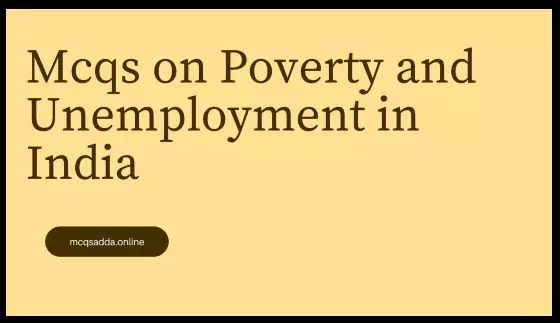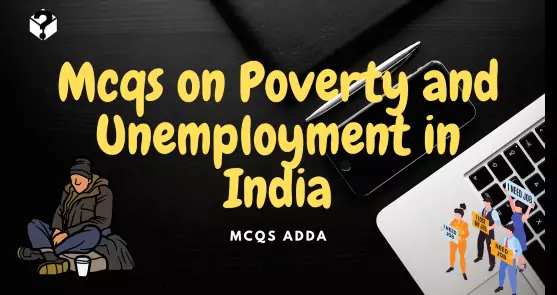Poverty and unemployment are major challenges in India. With a population of more than 1.3 billion, India is one of the most populous countries in the world, and yet it has one of the highest rates of poverty and unemployment in the world. Take this test on Mcqs on Poverty and Unemployment in India. I
Poverty and Unemployment in India
The is estimated that more than one-fourth of the population lives below the poverty line, and unemployment is estimated to be around 6.1%. There are various reasons for poverty and unemployment in India, including lack of education and skills, lack of employment opportunities, and lack of access to resources. The government of India has taken various steps to reduce poverty and unemployment, such as initiating job creation schemes, providing employment opportunities in rural areas, and encouraging self-employment. To better understand poverty and unemployment in India, let’s take a look at the following multiple-choice questions on the subject. Practice the Mcqs on Poverty and Unemployment in India and enrich your knowledge
Mcqs on Population, Poverty and Unemployment in India
Q1. Name the programme of poverty alleviation launched by the Govt. of India which was immensely benefited the rural poor-
(a) Jawahar Rojgar Yojana
(b) Indira Gandhi Rural Housing Programme (c) Food for Work programme
(d) National Rural Employment Guarantee Programme
Q2. The most important economic problem, India is currently facing is
(a) Inadequate supplies of infrastructural services
(b) Inadequate supplies of skilled manpower (c) Inefficiency of private sector firms
(d) None of the above
Q3. Community Development Programme started in
(a) 1952
(b) 1956
(c) 1972
(d) 1980
Q4. Balwantrai Mehta Committee was appointed
(a) To formulate child welfare programme
(b) To formulate National Security Policy
(c) To examine the Community Development Projects
(d) To formulate labour welfare programme
Q5. Mid-day Meal Scheme was launched in (a) 1996
(b) 1997
(c) 1998
(d) 1995
Q6. At Present the National Commission on population is under
(a) Ministry of Health
(b) Planning Commission
(c) Ministry of Human Resource Development (d) Cabinet Secretariat
Q7. This type of unemployment can occur even in a situation of full employment.
(a) Structural unemployment
(b) Functional unemployment
(c) Cyclical unemployment
(d) Disguised unemployment
Q8. ‘Disguised unemployment’ refers to:
(a) persons with no jobs
(b) more persons employed for a job which a few can Accomplish
(c) unemployment among women
(d) unemployment of people above 60 years of age
Q9. The type of unemployment mostly found in India can be characterised as:
(a) Disguised
(b) Cyclical
(c) Frictional
(d) Structural
Q10. Which of the following is associated with poverty estimation ?
(a) Tendulkar committee
(b) Lakdawala committee
(c) Saxena committee
(d) All the above
Q11. It introduced the new term “Poverty Line Basket” to determine and estimate poverty
(a) Tendulkar committee
(b) Lakdawala committee
(c) Saxena committee
(d) Rangarajan Committee
Q12. Which of the following is an indicator of poverty in India?
(a) Income level
(b) Illiteracy level
(c) Employment level
(d) All of these
Q13. Unemployment which occurs when workers move from one job to another job is known as:
(a) Cyclical unemployment
(b) Frictional unemployment
(c) Technological unemployment
(d) Seasonal unemployment
Q14. Which among the following are the eligible beneficiaries of the “Mahatma Gandhi National Rural Employment Guarantee Act” are?
Join our telegram channel here
(a) Adult members of any household
(b) Adult members of households of all backward communities
(c) Adult members of below poverty line
(BPL) households
(d) Adult members of only the scheduled caste and scheduled tribe households
Q15. Operation Blackboard aims at:
(a) Providing education to urban slum dwellers (b) Promoting adult literacy
(c) Opening of new schools specially for female children
(d) Providing primary education in an educationally backward area.
Q16. Poverty in underdeveloped countries is large because of:
(a) Lack of intelligence of the people
(b) Lack of cultural activities
(c) Income inequality
(d) Voluntary idleness
Q17. Pradhan Mantri Awaas Yojana was launched in
(a) 1999
(b) 2005
(c) 2015
(d) 2017
Q18. Which period is referred to as the period of steady population growth?
(a) 1901-1911
(b) 1911-1921
(c) 1921-1951
(d) 1951-1981
Q19. Which period is referred to as the period of population explosion in India?
(a) 1901-1911
(b) 1911-1921
(c) 1921-1951
(d) 1951-1981
Q20. Which committee was the first in India to define the poverty line.
(a) Rangarajan Committee
(b) Alagh Committee
(c) Lakdawala Formula
(d) Suresh Tendulkar Committee
Q21. Which committee was also based on household per capita expenditure?
(a) Rangarajan Committee
(b) Suresh Tendulkar Committee
(c) Lakdawala Formula
(d) Alagh Committee
Q22. Stand-up India Scheme aims at:
(a) Employment to at least 75% of the trained candidates.
(b) It aims to give financial and technical assistance to new start-ups
(c) This promotes the development of the non-farming sector in rural areas
(d) Empower SC/STs and women by giving them a loan.
Poverty and unemployment in India have been issues of serious concern in recent times. The World Bank estimates that around 22.5% of India’s population was living below the poverty line in 2019. The unemployment rate in India also stood at 6.1% as of August 2020. In this post, we look at some of the frequently asked questions (FAQs) on poverty and unemployment in India.
Questions on Poverty and Unemployment in India
Multiple Choice Questions Mcqs on Poverty and Unemployment in India aim to assess the understanding of the causes, effects and solutions to poverty and unemployment in India. These questions may cover topics such as:
- The definition of poverty and unemployment
- The various poverty lines and measurements used to estimate poverty in India
- The factors contributing to poverty and unemployment in India
- The impact of poverty and unemployment on individuals, families and communities
- Government policies and programs aimed at reducing poverty and unemployment in India
- The role of education, skill development and entrepreneurship in addressing poverty and unemployment
MCQs on Poverty and Unemployment in India can be useful for students, researchers, policy makers, and anyone interested in understanding the challenges faced by India in addressing poverty and unemployment.

Discover a curated collection of the finest books for competitive exams available now for purchase online, and enrich your knowledge with captivating insights and inspiring masterpieces. click here
FAQS
Q.1 What are the main causes of poverty and unemployment in India?
The main causes of poverty and unemployment in India include a lack of access to resources, widespread inequality, lack of education, low wages, lack of job opportunities, and a weak agricultural sector. Other factors such as health, climate change, access to credit, and population growth also contribute to poverty and unemployment in India.
Q.2 What are the impacts of poverty and unemployment in India?
A. Poverty and unemployment in India are associated with various negative impacts such as poor health and nutrition, lack of access to education and other basic services, increased crime and violence, and environmental degradation. Poverty and unemployment can also lead to social unrest, political instability, and economic stagnation.
Q.3 How can poverty and unemployment in India be tackled?
A. Poverty and unemployment in India can be tackled through various policy measures, such as increasing job creation, improving access to education and other basic services, encouraging the growth of small and medium enterprises, providing access to credit, and investing in infrastructure. The government also needs to focus on improving access to healthcare, increasing access to clean water, and improving the agricultural sector.
Q.4 What are the government policies that are addressing poverty and unemployment in India?
A. The government of India has implemented a variety of policies to address poverty and unemployment in India. These include the Mahatma Gandhi National Rural Employment Guarantee Act (MGNREGA), the Pradhan Mantri Awas Yojana (PMAY), the Pradhan Mantri Jan Dhan Yojana (PMJDY), the Pradhan Mantri Ujjwala Yojana (PMUY), and the Pradhan Mantri Rozgar Yojana (PMRY). The government has also introduced a number of schemes to support small and medium enterprises and encourage entrepreneurship.
